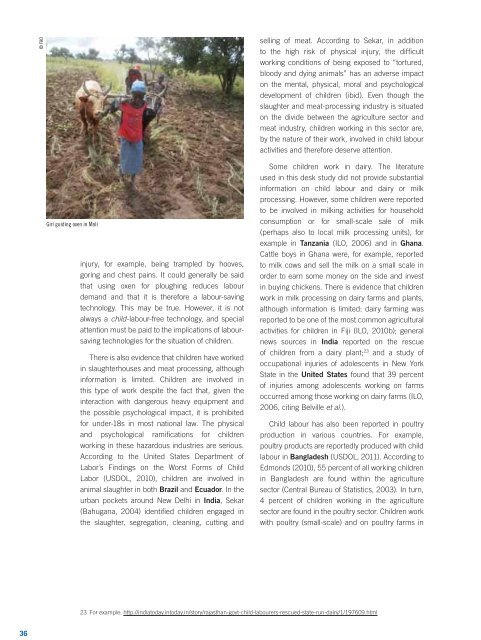Children’s work in the livestock sector: Herding and beyond
Children’s work in the livestock sector: Herding and beyond
Children’s work in the livestock sector: Herding and beyond
You also want an ePaper? Increase the reach of your titles
YUMPU automatically turns print PDFs into web optimized ePapers that Google loves.
36<br />
© FAO<br />
Girl guid<strong>in</strong>g oxen <strong>in</strong> Mali<br />
<strong>in</strong>jury, for example, be<strong>in</strong>g trampled by hooves,<br />
gor<strong>in</strong>g <strong>and</strong> chest pa<strong>in</strong>s. It could generally be said<br />
that us<strong>in</strong>g oxen for plough<strong>in</strong>g reduces labour<br />
dem<strong>and</strong> <strong>and</strong> that it is <strong>the</strong>refore a labour-sav<strong>in</strong>g<br />
technology. This may be true. However, it is not<br />
always a child-labour-free technology, <strong>and</strong> special<br />
attention must be paid to <strong>the</strong> implications of laboursav<strong>in</strong>g<br />
technologies for <strong>the</strong> situation of children.<br />
There is also evidence that children have <strong>work</strong>ed<br />
<strong>in</strong> slaughterhouses <strong>and</strong> meat process<strong>in</strong>g, although<br />
<strong>in</strong>formation is limited. Children are <strong>in</strong>volved <strong>in</strong><br />
this type of <strong>work</strong> despite <strong>the</strong> fact that, given <strong>the</strong><br />
<strong>in</strong>teraction with dangerous heavy equipment <strong>and</strong><br />
<strong>the</strong> possible psychological impact, it is prohibited<br />
for under-18s <strong>in</strong> most national law. The physical<br />
<strong>and</strong> psychological ramifications for children<br />
<strong>work</strong><strong>in</strong>g <strong>in</strong> <strong>the</strong>se hazardous <strong>in</strong>dustries are serious.<br />
Accord<strong>in</strong>g to <strong>the</strong> United States Department of<br />
Labor´s F<strong>in</strong>d<strong>in</strong>gs on <strong>the</strong> Worst Forms of Child<br />
Labor (USDOL, 2010), children are <strong>in</strong>volved <strong>in</strong><br />
animal slaughter <strong>in</strong> both Brazil <strong>and</strong> Ecuador. In <strong>the</strong><br />
urban pockets around New Delhi <strong>in</strong> India, Sekar<br />
(Bahugana, 2004) identified children engaged <strong>in</strong><br />
<strong>the</strong> slaughter, segregation, clean<strong>in</strong>g, cutt<strong>in</strong>g <strong>and</strong><br />
sell<strong>in</strong>g of meat. Accord<strong>in</strong>g to Sekar, <strong>in</strong> addition<br />
to <strong>the</strong> high risk of physical <strong>in</strong>jury, <strong>the</strong> difficult<br />
<strong>work</strong><strong>in</strong>g conditions of be<strong>in</strong>g exposed to “tortured,<br />
bloody <strong>and</strong> dy<strong>in</strong>g animals” has an adverse impact<br />
on <strong>the</strong> mental, physical, moral <strong>and</strong> psychological<br />
development of children (ibid). Even though <strong>the</strong><br />
slaughter <strong>and</strong> meat-process<strong>in</strong>g <strong>in</strong>dustry is situated<br />
on <strong>the</strong> divide between <strong>the</strong> agriculture <strong>sector</strong> <strong>and</strong><br />
meat <strong>in</strong>dustry, children <strong>work</strong><strong>in</strong>g <strong>in</strong> this <strong>sector</strong> are,<br />
by <strong>the</strong> nature of <strong>the</strong>ir <strong>work</strong>, <strong>in</strong>volved <strong>in</strong> child labour<br />
activities <strong>and</strong> <strong>the</strong>refore deserve attention.<br />
Some children <strong>work</strong> <strong>in</strong> dairy. The literature<br />
used <strong>in</strong> this desk study did not provide substantial<br />
<strong>in</strong>formation on child labour <strong>and</strong> dairy or milk<br />
process<strong>in</strong>g. However, some children were reported<br />
to be <strong>in</strong>volved <strong>in</strong> milk<strong>in</strong>g activities for household<br />
consumption or for small-scale sale of milk<br />
(perhaps also to local milk process<strong>in</strong>g units), for<br />
example <strong>in</strong> Tanzania (ILO, 2006) <strong>and</strong> <strong>in</strong> Ghana.<br />
Cattle boys <strong>in</strong> Ghana were, for example, reported<br />
to milk cows <strong>and</strong> sell <strong>the</strong> milk on a small scale <strong>in</strong><br />
order to earn some money on <strong>the</strong> side <strong>and</strong> <strong>in</strong>vest<br />
<strong>in</strong> buy<strong>in</strong>g chickens. There is evidence that children<br />
<strong>work</strong> <strong>in</strong> milk process<strong>in</strong>g on dairy farms <strong>and</strong> plants,<br />
although <strong>in</strong>formation is limited: dairy farm<strong>in</strong>g was<br />
reported to be one of <strong>the</strong> most common agricultural<br />
activities for children <strong>in</strong> Fiji (ILO, 2010b); general<br />
news sources <strong>in</strong> India reported on <strong>the</strong> rescue<br />
of children from a dairy plant; 23 <strong>and</strong> a study of<br />
occupational <strong>in</strong>juries of adolescents <strong>in</strong> New York<br />
State <strong>in</strong> <strong>the</strong> United States found that 39 percent<br />
of <strong>in</strong>juries among adolescents <strong>work</strong><strong>in</strong>g on farms<br />
occurred among those <strong>work</strong><strong>in</strong>g on dairy farms (ILO,<br />
2006, cit<strong>in</strong>g Belville et al.).<br />
Child labour has also been reported <strong>in</strong> poultry<br />
production <strong>in</strong> various countries. For example,<br />
poultry products are reportedly produced with child<br />
labour <strong>in</strong> Bangladesh (USDOL, 2011). Accord<strong>in</strong>g to<br />
Edmonds (2010), 55 percent of all <strong>work</strong><strong>in</strong>g children<br />
<strong>in</strong> Bangladesh are found with<strong>in</strong> <strong>the</strong> agriculture<br />
<strong>sector</strong> (Central Bureau of Statistics, 2003). In turn,<br />
4 percent of children <strong>work</strong><strong>in</strong>g <strong>in</strong> <strong>the</strong> agriculture<br />
<strong>sector</strong> are found <strong>in</strong> <strong>the</strong> poultry <strong>sector</strong>. Children <strong>work</strong><br />
with poultry (small-scale) <strong>and</strong> on poultry farms <strong>in</strong><br />
23 For example: http://<strong>in</strong>diatoday.<strong>in</strong>today.<strong>in</strong>/story/rajasthan-govt-child-labourers-rescued-state-run-dairy/1/197609.html


